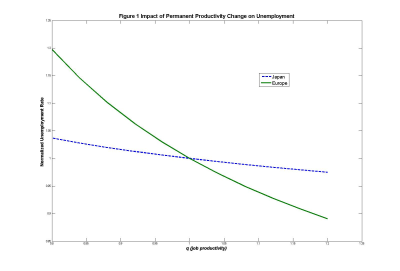Information
- Time and Date: 10:00 - 17:30, Friday, July 6, 2010
- Venue: London Business School, Room LT2
- Hosts: Centre for Economic Policy Research (CEPR) and Research Institute for Economy, Trade and Industry (RIETI)
- First Session
- Second Session
- Third Session
- Discussion Session
Summary
Second Session
"Japano-Sclerosis?"
Prof. Kenn Ariga (Professor, IER, Kyoto University)
Professor ARIGA presented an analysis using a competitive search model focusing on the unique characteristic of the Japanese labor market, which is virtually divided into two separate segments with new graduates systematically differentiated from other job seekers. His analysis showed that permanent productivity change would have a larger impact on wages in countries where the labor market resembles that of Japan, and on the unemployment rate in an integrated job market where all job seekers - whether new graduates or not - compete on an equal footing (Figure 2 ). The so-called Eurosclerosis in Europe can be understood as a result of a significant long-term rise in the unemployment rate brought on by declining productivity, combined with the effect of a more generous unemployment insurance system in comparison to Japan and the United States. Therefore, even if the lower productivity were to continue into the long term, the rise in the unemployment rate experienced in Europe is unlikely to be seen in the labor market in Japan. However, if new graduates are differentiated from other job seekers and training is firm specific, the effect of a failure to find employment in the new graduate market will be greater in Japan than in Europe, as the labor market places more emphasis on worker quality than experience.

[Click to enlarge]
"European Perspective"
Prof. Torben Andersen (Professor, School of Economics and Management at Aarhus University)
Professor ANDERSEN explained about Sclerosis (particularly high unemployment among the youth) in Europe, the phenomenon behind the title of Professor Ariga's paper, and pointed out that the long-term trend of employment in Europe has not improved, in contrast to Japan and the United States (Figure 3). During the discussion, opinions were exchanged on appropriate responses, including flexibility of the labor market.


